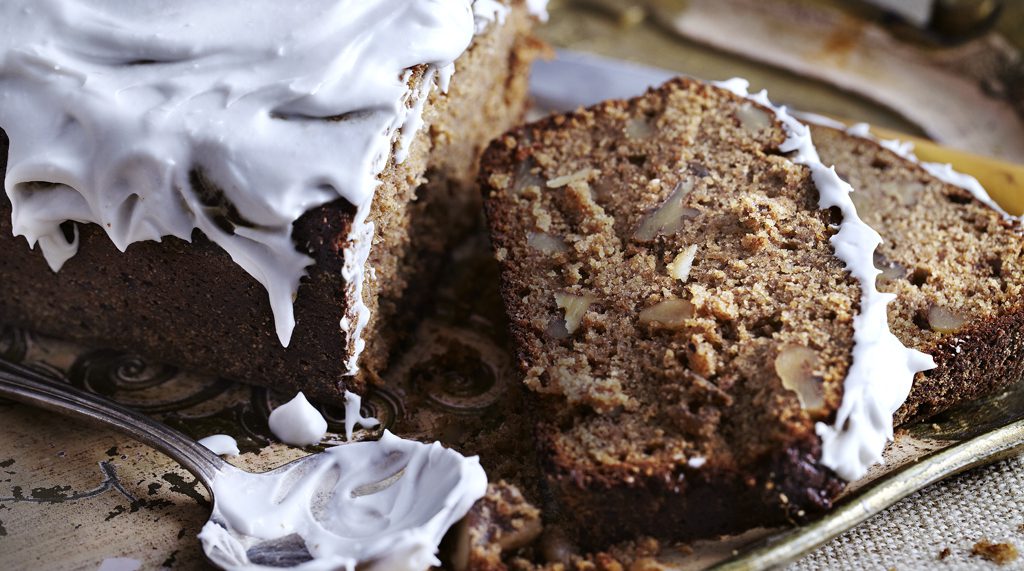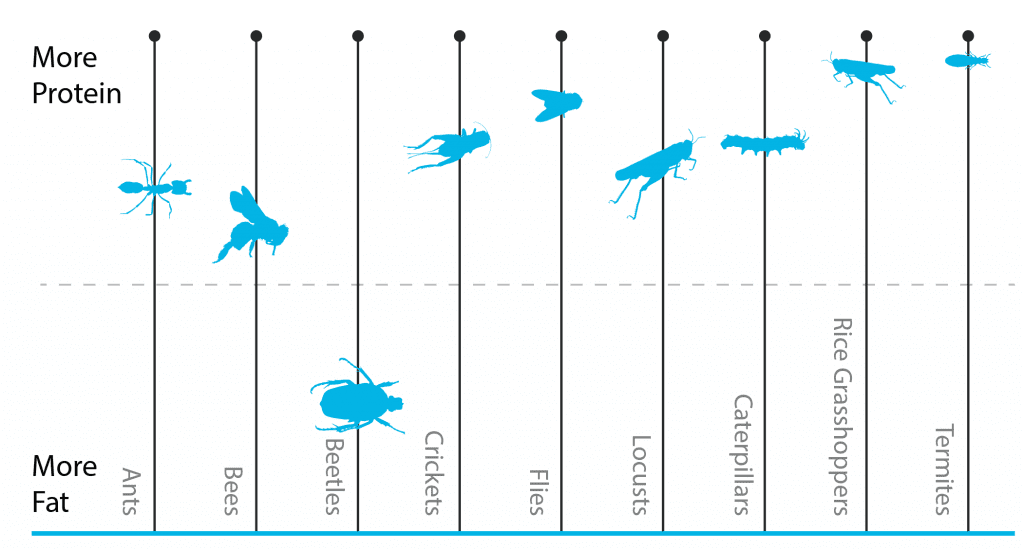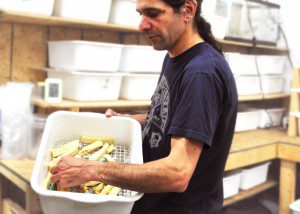Think eating bugs is gross? Think again. A new generation of chefs, farmers, sustainability experts, and adventure eaters is embracing entomophagy (insect-eating). Fitness enthusiasts might be the next group to jump on the buggy bandwagon. Krista Scott-Dixon explores why.
[Note: we’ve also prepared an audio recording of this article for you to listen to. So, if you’d rather listen to the piece, click here.]
++
Mmmm. Banana bread with coconut icing.

Looks delicious, doesn’t it?
It is! And guess what: It’s made with cricket flour.
Want the recipe? Just scroll down to the bottom of this article.
But while you’re here, check out the rest of the piece. It might challenge your ideas about eating insects.
Girl meets bug
A jewel-toned caterpillar nestles into my palm. His (hers? its?) little feet, like tiny whiskers, poke my skin. I pet the peristaltic turquoise tube in my hand. It has teeny figure-8 markings along its tummy. It’s baby-bottom soft.
Not what I expected.
I munch on a toasted hornworm. It’s like a pork rind. Then I pop a chocolate-coated cricket. This is too tasty to be healthy.
Not what I expected either.
In fact, as you can see from the banana bread photo above, “Not what you’d expected,” could almost be the tagline for eating insects. Because it’s just not as gross as you think it might be.
Beyond the “ew” factor
Ask most North Americans how they feel about eating bugs and you’ll get one response: Yuck!
We Western Anglos like our protein neatly packaged. Something plastic, no yucky stuff. Nothing that implies this protein came from an actual body.
We prefer pallid chicken breasts to musky, iron-scented livers or hearts. We prefer burgers and neatly trimmed steaks to tendons and stomachs.
We feel virtuous about dessert-flavored protein powder and bars. We make egg white omelets from a carton (eggs come from a chicken’s butt? Gross!) And oh, how we love our nuggets and hot dogs.
Yet, worldwide, we’re the weirdos.
Go to a market in sub-Saharan Africa or southeast Asia and edible insects will be as common as pretzels in New York City.
Considering that insects first appeared around 400 million years ago — which means around 398 million years before modern humans, give or take a few million years — and that of the known 950,000 or so bug species out there, humans eat nearly 2000 types of them, entomophagy (from the Greek entomon, or insect, and phagein, or to eat) isn’t exactly a novelty.
But still. Ew.
So how do you get squeamish eaters to buy in?
Simple: By showing how bugs are nutritious and delicious.
And more than that: a sustainable, ecologically viable food source.

Insect nutrition
Lean protein: Health-conscious people and athletes are always hunting for it. Scanning menus. Dumping powder into shakes. Reading labels.
What if there were a convenient, shelf-stable, portable source of protein that was still “real food”?
Well, you’ve got jerky. Canned tuna. And… not much else.
Jarrod Goldin, along with his brothers Ryan and Darren, wants to change that. They run Next Millennium Farms, in Toronto, which I’m visiting.
As I let a hawkmoth alight on me, Jarrod hands me a foil bag of mealworms. They’re pretty obviously real food. I mean, they look like… mealworms. The whole thing.
Gamely, I dump out a handful and pop it into my mouth. It’s a bit like Rice Krispies, but roastier-tasting. Delicious.
“These would be good with some garlic salt,” I say, trying not to spit mealworm crumbs as I talk.
“Yeah,” says Jarrod, “you can put them over a salad like croutons. Instead of your chicken breast, say, you could sprinkle these on top.”
I’m already reaching into the bag again. I can totally imagine chowing through a container of these while watching TV.
Except instead of a bag of chips, which would leave me with zero nutrition (and arguably, negative nutrition for the health it subtracts from my body), a bag of mealworms gives me protein, fiber, fatty acids, and minerals.
The average insect is around half protein by dry weight, with some insects (such as locusts) up to about 75% protein.
This means that insects are comparable to other animal protein sources, without many of the other nutritional problems of factory-farmed livestock (such as overuse of antibiotics, hormones, and grain feed).

Cooking with bugs
Of course, though you might agree with the superior nutritional qualities, you might also ask the obvious question:
How does this stuff taste?
In my opinion: Damn good.
Before my visit to Next Millennium to see their operations, I experiment with their cricket and mealworm flours, which are simply the whole insects ground into a fine powder, like a buggy talcum.
The flours taste like toast crusts — as if someone’s powderized a well-done slice of bread. There’s a roasty, nutty flavor to them.
I make cricket cakes and cookies. Mealworm powder goes into my Super Shakes. Eventually I just spoon the stuff out and eat it straight. I think I’m hooked.
For some reason, many folks assume that eating bugs means consuming them — as Gollum would say — raw and wriggling. As in, “stick your open-mouthed head into a tank of live crawling cockroaches, like on Fear Factor”.
My response to this is: “And how do you eat chickens, exactly? Do you shove your head into a henhouse and start randomly chomping?”
Of course not.
So, dear reader, in case you were wondering: Although “I ate a live ___” is the stuff that travel adventure stories are made of, insects bred for food in North America are painlessly euthanized, then processed into food, e.g. by roasting.
That means they are dead, cooked, and possibly even powderized by the time they get to you. No more Fear Factor than a shrimp cocktail.
Kosher dietary rules specify which types of insects observant Jews may eat.
All flying insects that walk on all fours are to be detestable to you. There are, however, some winged creatures that walk on all fours that you may eat: those that have jointed legs for hopping on the ground. Of these you may eat any kind of locust, katydid, cricket or grasshopper. But all other winged creatures that have four legs you are to detest.
–Leviticus 11
There is some debate among Islamic scholars about whether insects are technically halal (allowed) or haram (forbidden). According to some writers, a few types of insects may be halal, and insects that find their way into food accidentally (such as the proverbial fly in one’s soup) are generally given a pass. However, in general, most insects are considered haram for Muslims.
Making bugs tasty
Innovative celebrity chefs are starting to experiment with insectivory.
In 2008, the famous Vancouver Indian restaurant Vij’s put cricket flour paratha on its menu. In Toronto, chef Nathan Isberg of The Atlantic regularly does bug cuisine, and Olivier de Calvez of El Catrin offers a cricket taco. Michelin-starred UK chef Peter Gorton offers a multi-course insect menu, including mealworm and mushroom soup.
Fitness foodies are also exploring their options. Companies such as Exo and Chapul both make bug-based bars. (Coach Ryan Andrews smuggles a Chapul chocolate cayenne espresso bar into Canada for me. It’s scrumptious.)
Not ones to back down from a challenge, we wanted to see what we could do with bugs. So we asked resident food photographer Jay Grenci to come up with a couple of ideas.
Here are two of his favorites.
Cricket Banana Bread with Coconut Icing
- 4 medium ripe bananas
- 2 eggs
- 1 ½ cups coconut sugar
- ½ cups mild olive oil
- ½ cup cricket flour
- 1 ¾ cups whole grain wheat flour
- 2 tsp baking powder
- 1 ½ handfuls of walnut pieces
Icing (optional)
- 1 can (398mL) coconut cream
- 1 ½ tbsp runny honey
Preheat an oven on normal bake setting (not convection) to 350 F (175 C).
Grease a loaf pan. Then dust it with flour to coat the surface. (This will prevent the banana bread from sticking. You can also use a silicone or nonstick loaf pan.)
In an electric mixing bowl, mix bananas, eggs, sugar, and olive oil. Mix well on medium speed, for about 45 seconds.
Add cricket flour, whole grain wheat flour, and baking powder. Mix together on low speed for about 15 seconds.
Turn off the mixer and scrape down the sides with a rubber spatula to get any flour that remains into the batter. Mix the batter on medium speed for a minute or two. Mix in the walnut pieces by hand, with the spatula.
Pour the batter into the prepared loaf pan, and place into the heated oven for about 1 hour.
To test donenness, poke a toothpick or clean knife into the center of the loaf. If it comes out clean, the loaf is done.
Let it cool until you can easily handle it, and then remove it from the pan.
To make the optional icing, whip coconut cream with honey. Then slather it over the top of the bread.
Cut into slices and serve.

Spiced Cricket Flour Cookies
Adapted from Next Millennium Farms’ recipe. Makes about 24 cookies
- ½ cup cricket flour
- 2/3 cup almond meal
- 1 1/3 cup general all purpose flour – organic unbleached
- ¾ tsp ground ginger
- ¾ tsp ground cinnamon
- ½ tsp ground cloves
- 1 tsp baking powder
- ¼ tsp salt
- ¾ cup soft butter
- ½ cup runny honey
- ¼ cup old fashioned brown sugar (or coconut sugar)
- 1 egg
- 3 tbsp molasses
- 1 tbsp orange juice
Preheat an oven on normal bake setting (not convection) to 350 F (175 C).
In a mixing bowl, combine cricket flour, almond meal, general purpose flour, ginger, cinnamon, cloves, baking powder and salt by mixing with a whisk gently.
In an electric mixer bowl, add the butter and honey, plus brown sugar/ or coconut sugar. Cream together for about 30 seconds on medium-high setting, with a paddle attachment.
Beat in the egg, molasses, and orange juice.
Add the dry ingredients to the butter batter, and mix to incorporate on slow setting on the electric mixer.
Put into the fridge for 20-30 minutes.
Prepare a cookie sheet with parchment paper. (Or use a silicon baking mat.)
With cold hands, scoop out 1 tbsp of the dough, and roll into little balls. Place on cookie tray. Press down on each cookie until they are about half their size.
Place into the oven for about 10 minutes, or until they appear golden brown.
Remove from the oven, and cool until you are able to handle it with your hands.
Serve warm with a coffee, or refrigerate and/or freeze them for future use.

Sustainability
Next Millennium Farms isn’t really a “farm” as you probably understand the term. There are no fields, no barns, no fences. The facility we visit — one of three where NMF does their buggy work — is a low-slung, nondescript industrial building in suburban Toronto.
Aside from a few stray moths on the wall, the resident lizard (named Samosa), and the two fridges (“Make sure you don’t pick the incubator one”, advises co-owner Ryan Goldin) you’d never know it was technically an agricultural production site.
Inside, the facility is like an ongoing biology lesson.
Hawkmoths and mealworms in various stages of development squirm away in shelves of plastic containers. Inside the dark, dusty moth room, hundreds of flapping moths make sweet love to one another, sip at the hummingbird feeders laid out for them, and lay eggs on plants. Pupae are, well, pupating.
A table of bug food, resembling pale cornbread, awaits insectoid diners. New Millennium Farms uses a wheat germ based medium, but is also experimenting with non-grain-fed crickets, in order to make what they call “a truly Paleo product”. They also feed some of their insects apples and cinnamon to flavor the end product.
“The cool thing about insect farming,” explains Jarrod, gesturing at the shelves of plastic buckets, inside which mealworms are presumably living out little mealworm soap operas, “is that it has such a small footprint.
“You can go vertical with it. We can stack these things right on top of each other.”
“Compare that to a cow. Even just one cow needs a lot of space. And a lot of resources.”
In addition, insect lives are typically short. An average cricket might live 2-3 months; a moth might live 3-6 months. If grown for the larvae (as in the case of mealworms or hornworms), it’s not even necessary to let them pupate, which means that a farmer can go from egg to final product in several weeks.
Insects are also very, very good at converting food into edible tissue — about twice as efficient as chickens and pigs, and more than five times as efficient as beef cattle. Jarrod estimates that between his three facilities in Toronto, Next Millennium can produce thousands of pounds of edible insects a month.
Plus, insects are happy to eat a much wider range of plants than conventional livestock. There are no complaints about the bland wheat germ mush in the caterpillar lunch line.
They’re often able to eat things (such as mulberry leaves or wood) that humans can’t eat, as well as improve the quality of the proteins in the plants, which means transforming unavailable food sources into something viable and valuable for people.
Thus, considering all factors, the actual food conversion efficiency of insects may be 20 times that of cattle. This means insect farming — along with other forms of “microlivestock”, could be one of the elements of a sustainable global agricultural future.
Check out the photos below — click on any individual photo to scroll through the album — for an inside view of life at a bug farm.
Fighting hunger
According to the Food and Agriculture Organization of the United Nations, one in six people worldwide will die of hunger and under-nourishment.
Good soil and fresh, clean water are quickly disappearing. Crop diversity is decreasing. Large-scale commercial livestock production is becoming increasingly difficult, especially in world regions where resources are scarce.
Entomophagy offers one possible solution to the global problem of food shortages, over-farming, and depletion of natural resources.
Some researchers estimate that there are as many as 1018 (that’s 10 quintillion) individual insects alive at any given time. Even if we only eat 2000-ish types of them, that’s a pretty darn good start.
Insects may also offer astronauts an easy-grow food option for sustained space missions.
Whether chefs, farmers, bug enthusiasts, sustainability experts, or simply adventurous eaters, people are catching on to eating insects.
Entomophagy isn’t the only option for more ethical and sustainable eating, but it’s a good one
But forget the sustainability for a moment. These things taste good. And they’re good for you. Wins all around.
After leaving the cricket farm, I drop off my rental car.
“So, where did you go?” asks the desk agent pleasantly.
I smile. “Bug farm.”
I proffer the mealworm bag. “Want some? They’re delicious!”
She wrinkles her nose. “People… eat those?”
Yeah. They do. “Like Rice Krispies, these ones,” I say, trying to be encouraging.
“Ew.” She can’t go there with me yet. “I’m sorry, I don’t mean to be rude, but…” Her voice trails off. I understand completely.
I’ll come back in a few years.
What to do
Thinking about adding insects to your menu but aren’t sure how to begin? Here are a few suggestions.
- Review the nutritional profile. Even if you’re a hesitant eater, the nutritional value is pretty compelling. Think about where you might blend in cricket or mealworm flour to boost the nutrient power.
- Try starting with the easiest option. Cricket or mealworm flour. It blends into a Super Shake or soup, or can be combined into baked goods such as pancakes or muffins. You don’t have to go full cricket right off the bat.
- Add flavor. Try dark-chocolate-covered insects as a sweet snack, or one of the many flavored varieties available. Or buy a bag of toasted mealworms and experiment with your own flavor combos. (We’re liking garlic and chili).
- Incorporate insects into your favorite dishes. Ground insects are the easiest way to get started. But if you’re more adventurous, try sprinkling mealworms on a salad like croutons.
Where to find edible insect products
Cricket flour bars
Whole insects / flour
- Next Millennium Farms (Canada)
Recipes
- David George Gordon, The Eat A Bug Cookbook.
References
Click here to view the information sources referenced in this article.
Eat, move, and live…better.©
The health and fitness world can sometimes be a confusing place. But it doesn't have to be.
Let us help you make sense of it all with this free special report.
In it you'll learn the best eating, exercise, and lifestyle strategies – unique and personal – for you.










Share